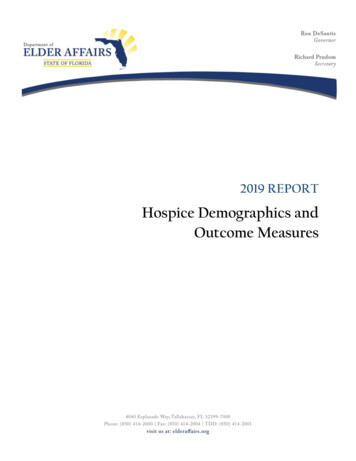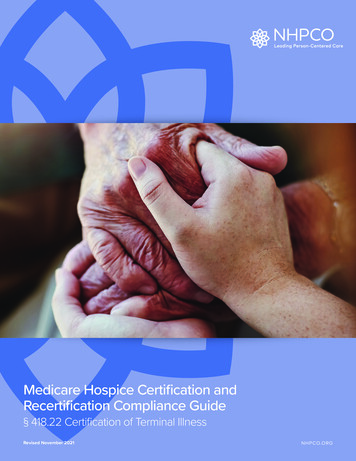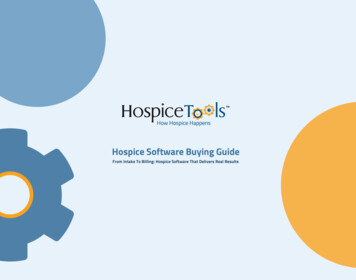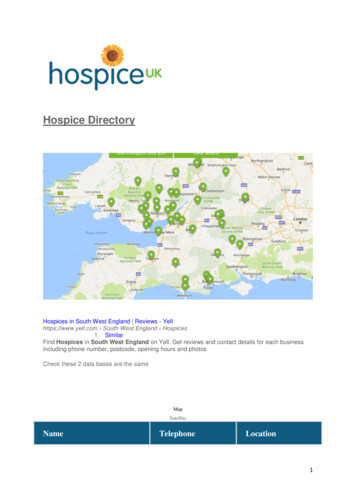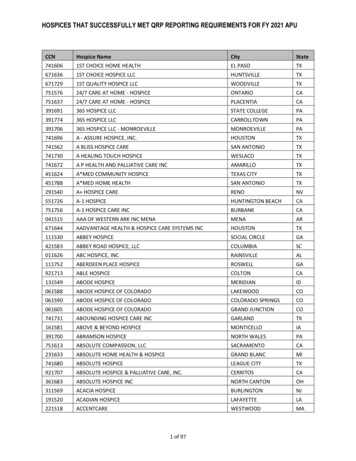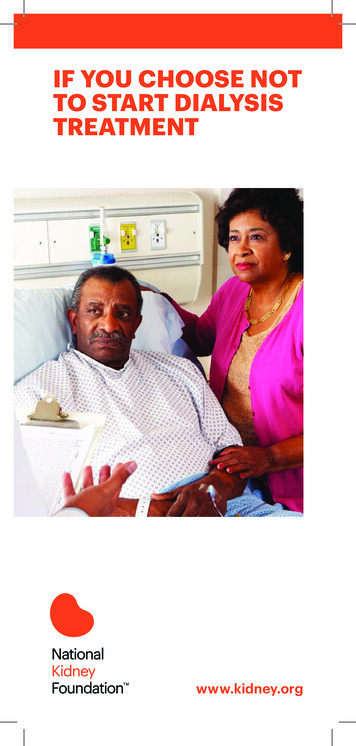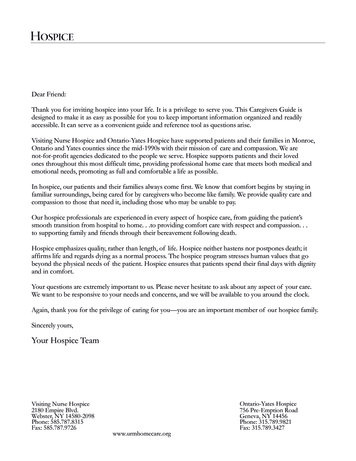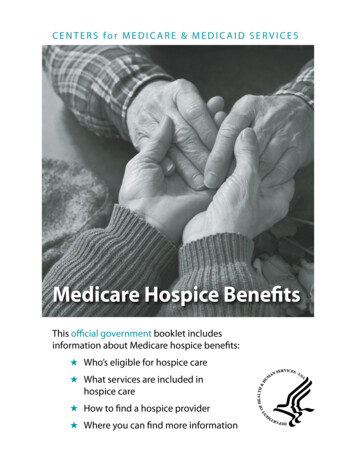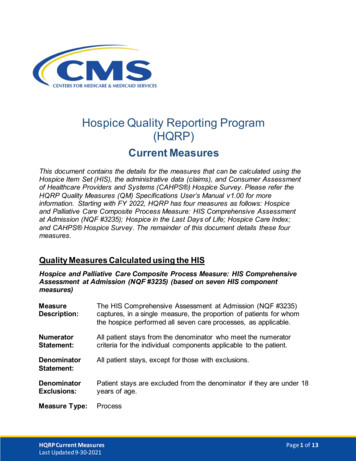
Transcription
Hospice Quality Reporting Program(HQRP)Current MeasuresThis document contains the details for the measures that can be calculated using theHospice Item Set (HIS), the administrative data (claims), and Consumer Assessmentof Healthcare Providers and Systems (CAHPS ) Hospice Survey. Please refer theHQRP Quality Measures (QM) Specifications User’s Manual v1.00 for moreinformation. Starting with FY 2022, HQRP has four measures as follows: Hospiceand Palliative Care Composite Process Measure: HIS Comprehensive Assessmentat Admission (NQF #3235); Hospice in the Last Days of Life; Hospice Care Index;and CAHPS Hospice Survey. The remainder of this document details these fourmeasures.Quality Measures Calculated using the HISHospice and Palliative Care Composite Process Measure: HIS ComprehensiveAssessment at Admission (NQF #3235) (based on seven HIS componentmeasures)MeasureDescription:The HIS Comprehensive Assessment at Admission (NQF #3235)captures, in a single measure, the proportion of patients for whomthe hospice performed all seven care processes, as applicable.NumeratorStatement:All patient stays from the denominator who meet the numeratorcriteria for the individual components applicable to the patient.DenominatorStatement:All patient stays, except for those with exclusions.DenominatorExclusions:Patient stays are excluded from the denominator if they are under 18years of age.Measure Type:ProcessHQRP Current MeasuresLast Updated 9-30-2021Page 1 of 13
List and description of the 7 HIS component measures used to calculate the HISComprehensive Assessment at Admission (NQF #3235):HIS Component MeasureDescriptionBeliefs/Values Addressed(if desired by the patient)Percentage of patient stays with documentation of adiscussion of spiritual/religious concerns ordocumentation that the patient and/or caregiver did notwant to discuss spiritual/religious concerns.Treatment PreferencesPercentage of patient stays with chart documentationthat the hospice discussed (or attempted to discuss)preferences for life sustaining treatments.Pain ScreeningPercentage of patient stays during which the patientwas screened for pain during the initial nursingassessment.Pain AssessmentPercentage of patient stays during which the patientscreened positive for pain and received acomprehensive assessment of pain within 1 day of thescreening.Dyspnea ScreeningPercentage of patient stays during which the patientwas screened for dyspnea during the initial nursingassessment.Dyspnea TreatmentPercentage of patient stays during which the patientscreened positive for dyspnea and received treatmentwithin 1 day of the screening.Patients Treated with anOpioid who are Given aBowel RegimenPercentage of patient stays treated with an opioid thatare offered/prescribed a bowel regimen ordocumentation of why this was not needed.Visit the CMS HQRP website and the Downloads section of the Current Measures page formore information about this measure and the 7 individual component measures: For calculation of the 7 individual measures, review the HQRP QM SpecificationsUser’s Manual v1.00. For background and methodology about NQF #3235, see Hospice ComprehensiveAssessment QM Background and Methodology Fact Sheet (PDF). For a one-page overview of the measure, review HIS Comprehensive Assessment atAdmission (NQF #3235).HQRP Current MeasuresLast Updated 9-30-2021Page 2 of 13
Quality Measures Calculated using Administrative Data (Medicare claims)Hospice Visits in Last Days of Life (HVLDL)MeasureDescription:The HVLDL measure assesses hospice staff visits to patients at theend of life. This measure is constructed from Medicare hospiceclaims records. It indicates the hospice provider’s proportion ofpatients who have received in-person visits from a registered nurseor medical social worker on at least two out of the final three days ofthe patient’s life.Note: The last three days are defined as: (Day 1) the day of death,(Day 2) the day prior to death, (Day 3) the day two days prior todeath.NumeratorStatement:The number of patient stays in the denominator in which the patientand/or caregiver received in person visits from registered nurses ormedical social workers on at least two of the final three days of thepatient’s life, as captured by hospice claims records.Note: Any visits occurring after the time of the patient’s death do notcount towards the measure score.DenominatorStatement:All hospice patient stays except those meeting exclusion criteria asidentified below.DenominatorExclusions:Patients are excluded from the denominator if: They did not expire in hospice care as indicated by reason fordischarge They received any continuous home care, respite care orgeneral inpatient care in the final three days of life They were enrolled in hospice for fewer than three daysNote: HVLDL looks at visits in the last three days of life; patientsmust receive hospice services for at least three days to be includedin the measure.Measure Type:ProcessHospice Care Index (HCI)MeasureDescription:The Hospice Care Index (HCI) captures care processes occurringthroughout the hospice stay, between admission and discharge. TheHCI is a single measure comprising ten indicators calculated fromHQRP Current MeasuresLast Updated 9-30-2021Page 3 of 13
Medicare claims data. The indicators included in the HCI are definedin the table below.The index design of the HCI simultaneously monitors all tenindicators. Collectively these indicators represent different aspects ofhospice service and thereby characterize hospices comprehensively,rather than on just a single care dimension. Each indicator equallyaffects the single HCI score, reflecting the equal importance of eachaspect of care delivered from admission to discharge.NumeratorStatement:The HCI does not have a traditional numerator statement. Instead, ahospice is awarded a point for meeting each criterion for each of theten claims-based indicators. The sum of the points earned frommeeting the criterion of each individual indicator results in thehospice's HCI score. HCI scores can range from 0 to a perfect 10.DenominatorStatement:The HCI does not have a traditional denominator. The HCI score iscalculated as the total number of points earned across ten indicators(hospices earn a point on an indicator when their indicator scoresmeet the criterion for the given indicator). The potential range ofscores is from 0 to 10.DenominatorExclusions:Hospices with fewer than 20 discharges in the two pooled years ofdata are not assigned a calculated index score per convention ofCMS's quality reporting program (requiring sufficient data available tocalculate reliable scores for publicly displayed measures).Measure Type:ProcessHQRP Current MeasuresLast Updated 9-30-2021Page 4 of 13
HCI Indicators – Description and Criteria for Each of the 10 Indicators.HCI IndicatorDescriptionIndex EarnedPoint CriteriaContinuous Home Care(CHC) or General Inpatient(GIP) ProvidedThe percentage of hospice servicedays that were provided at theContinuous Home Care (CHC) orGeneral Inpatient (GIP) level of care.The percentage of hospice elections,of at least 30 days, where the patientexperienced at least one gapbetween nursing visits exceeding 7days.The percentage of all live dischargesfrom hospice occurring within thefirst 7 days after hospice admission.The percentage of all live dischargesfrom hospice occurring on or after180 days after hospice admission.The percentage of all live dischargesfrom hospice that were followed byhospitalization within two days, andfollowed by hospice readmissionwithin two days of hospitaldischarge.Hospice ScoreAbove 0%The percentage of all live dischargesfrom hospice that were followed byhospitalization within two days, andwhere the patient also died duringthe inpatient hospitalization stay.Below 90Percentile RankAverage per-beneficiary Medicarepayments (in U.S. dollars): the totalnumber of payments Medicare paidto hospice providers divided by thetotal number of hospice beneficiariesserved.Average total skilled nurse minutesprovided by hospices on all RoutineHome Care (RHC) service days: thetotal number of skilled nurse minutesprovided by the hospice on all RHCBelow 90Percentile RankGaps in Skilled NursingVisitsEarly Live DischargesLate Live DischargesBurdensome Transitions(Type 1)Live Discharges fromHospice Followed byHospitalization andSubsequent HospiceReadmissionBurdensome Transitions(Type 2)Live Discharges fromHospice Followed byHospitalization with thePatient Dying in the HospitalPer-beneficiary MedicareSpendingSkilled Nursing CareMinutes per Routine HomeCare (RHC) DayHQRP Current MeasuresLast Updated 9-30-2021Below 90Percentile RankBelow 90Percentile RankBelow 90Percentile RankBelow 90Percentile RankAbove 10Percentile RankPage 5 of 13
Skilled Nursing Minutes onWeekendsVisits Near Deathservice days divided by the totalnumber of RHC days the hospiceserviced.The percentage of skilled nursevisits minutes that occurred onSaturdays or Sundays out of allskilled nurse visits provided by thehospice during RHC service days.The percentage of beneficiariesreceiving at least one visit by askilled nurse or social worker duringthe last three days of the patient’slife (a visit on the date of death, thedate prior to the date of death, ortwo days prior to the date of death).Above 10Percentile RankAbove 10Percentile RankThe points earned on each indicator are summed to result in the single HCI ObservedScore. For more information on the 10 HCI indicator measures and how they arecalculated, please refer to the HQRP QM Specifications User’s Manual v1.00 locatedin the Downloads section of the Current Measures page.Quality Measures calculated from the CAHPS Hospice SurveyAll eight of the CAHPS Hospice Survey measures are endorsed under NQF #2651. Detailson how to score CAHPS Hospice Survey measures can be found nalysis/.Communication With FamilyMeasureDescription:Multi-item measure. "While your family member was in hospicecare." P1: “How often did the hospice team keep you informedabout when they would arrive to care for your family member?” P2:“How often did the hospice team explain things in a way that waseasy to understand?” P3: “How often did the hospice team listencarefully to you when you talked with them about problems withyour family member’s hospice care?” P4: “How often did thehospice team keep you informed about your family member’scondition?” P5: “How often did the hospice team listen carefully toyou? P6: "How often did anyone from the hospice team give youconfusing or contradictory information about your family member’scondition or care?"Note: All items have response options of “Never,” “Sometimes,”HQRP Current MeasuresLast Updated 9-30-2021Page 6 of 13
“Usually,” “Always.”NumeratorStatement:CAHPS Hospice Survey measures are calculated using top-boxscoring. The top-box score refers to the percentage of caregiverrespondents that give the most positive response. For questions P1through P5 in this measure, the top box numerator is the number ofrespondents who answer “Always.” For question P6, the top boxnumerator is the number of respondents who answer “Never.” Topbox scores for each survey question within the measure areadjusted for mode of survey administration (at the individualrespondent level) and case mix (at the hospice level), and thenaveraged to calculate the overall hospice-level measure score.DenominatorStatement:The top box denominator is the number of respondents whoanswer at least one question in the multi-item measure (i.e., one ofP1 through P6).Exclusions:The hospice patient is still alive -The decedent’s age at death wasless than 18 -The decedent died within 48 hours of his/her lastadmission to hospice care -The decedent had no caregiver ofrecord -The decedent had a caregiver of record, but the caregiverdoes not have a U.S. or U.S. Territory home address -Thedecedent had no caregiver other than a nonfamilial legal guardian The decedent or caregiver requested that they not be contacted(i.e., by signing a no publicity request while under the care ofhospice or otherwise directly requesting not to be contacted) -Thecaregiver is institutionalized, has mental/physical incapacity, has alanguage barrier, or is deceased -The caregiver reports on thesurvey that he or she “never” oversaw or took part in decedent’shospice careMeasure Type:OutcomeGetting Timely HelpMeasureDescription:Multi-item measure P1: “While your family member was in hospicecare, when you or your family member asked for help from thehospice team, how often did you get help as soon as you needed it?”P2: “How often did you get the help you needed from the hospiceteam during evenings, weekends, or holidays?”Note: Both items have response options of “Never,” Sometimes,”“Usually,” “Always.”HQRP Current MeasuresLast Updated 9-30-2021Page 7 of 13
NumeratorStatement:CAHPS Hospice Survey measures are calculated using top-boxscoring. The top-box score refers to the percentage of caregiverrespondents that give the most positive response. The top boxnumerator is the number of respondents who answer “Always.” Topbox scores for each survey question within the measure are adjustedfor mode of survey administration (at the individual respondent level)and case mix (at the hospice level), and then averaged to calculatethe overall hospice-level measure score.DenominatorStatement:The top box denominator is the number of respondents who answerat least one question in the multi-item measure (i.e., one of P1 orP2).Exclusions:-The hospice patient is still alive -The decedent’s age at death wasless than 18 -The decedent died within 48 hours of his/her lastadmission to hospice care -The decedent had no caregiver of record-The decedent had a caregiver of record, but the caregiver does nothave a U.S. or U.S. Territory home address - The decedent had nocaregiver other than a nonfamilial legal guardian -The decedent orcaregiver requested that they not be contacted (i.e., by signing a nopublicity request while under the care of hospice or otherwise directlyrequesting not to be contacted) -The caregiver is institutionalized,has mental/physical incapacity, has a language barrier, or isdeceased -The caregiver reports on the survey that he or she “never”oversaw or took part in decedent’s hospice care.Measure Type:OutcomeTreating Patient With RespectMeasureDescription:Multi-item measure P1: “While your family member was in hospicecare, how often did the hospice team treat your family member withdignity and respect?” P2: “While your family member was in hospicecare, how often did you feel that the hospice team really cared aboutyour family member?Note: All items have response options of “Never,” “Sometimes,”“Usually,” “Always.”NumeratorStatement:CAHPS Hospice Survey measures are calculated using top-boxscoring. The top-box score refers to the percentage of caregiverrespondents that give the most positive response. For both questionsin this measure, the top box numerator is the number of respondentswho answer “Always.” Top box scores for each survey question withinthe measure are adjusted for mode of survey administration (at theindividual respondent level) and case mix (at the hospice level), andHQRP Current MeasuresLast Updated 9-30-2021Page 8 of 13
then averaged to calculate the overall hospice-level measure score.DenominatorStatement:The top box denominator is the number of respondents who answerat least one question in the multi-item measure (i.e., one of P1 orP2).Exclusions:The hospice patient is still alive -The decedent’s age at death was lessthan 18 -The decedent died within 48 hours of his/her last admission tohospice care -The decedent had no caregiver of record -The decedenthad a caregiver of record, but the caregiver does not have a U.S. orU.S. Territory home address -The decedent had no caregiver other thana nonfamilial legal guardian -The decedent or caregiver requested thatthey not be contacted (i.e., by signing a no publicity request while underthe care of hospice or otherwise directly requesting not to be contacted)-The caregiver is institutionalized, has mental/physical incapacity, hasa language barrier, or is deceased -The caregiver reports on the surveythat he or she “never” oversaw or took part in decedent’s hospice careMeasure Type:OutcomeEmotional and Spiritual SupportMeasureDescription:Multi-item measure P1: “While your family member was in hospicecare, how much emotional support did you get from the hospiceteam?” P2: “In the weeks after your family member died, how muchemotional support did you get from the hospice team?” P3: “Supportfor religious or spiritual beliefs includes talking, praying, quiet time, orother ways of meeting your religious or spiritual needs. While yourfamily member was in hospice care, how much support for yourreligious and spiritual beliefs did you get from the hospice team?”Note: All items have response options of “Too little,” “Right amount,”“Too much.”NumeratorStatement:CAHPS Hospice Survey measures are calculated using top-boxscoring. The top-box score refers to the percentage of caregiverrespondents that give the most positive response. For all questions inthis measure, the top box numerator is the number of respondentswho answer “Right amount.” Top box scores for each survey questionwithin the measure are adjusted for mode of survey administration (atthe individual respondent level) and case mix (at the hospice level),and then averaged to calculate the overall hospice-level measurescore.DenominatorStatement:The top box denominator is the number of respondents who answerat least one question in the multi-item measure (i.e., one of P1through P3). Those who answer “Too much” are not included inHQRP Current MeasuresLast Updated 9-30-2021Page 9 of 13
measure scoring.Exclusions:The hospice patient is still alive -The decedent’s age at death was lessthan 18 -The decedent died within 48 hours of his/her last admissionto hospice care -The decedent had no caregiver of record -Thedecedent had a caregiver of record, but the caregiver does not have aU.S. or U.S. Territory home address -The decedent had no caregiverother than a nonfamilial legal guardian -The decedent or caregiverrequested that they not be contacted (i.e., by signing a no publicityrequest while under the care of hospice or otherwise directlyrequesting not to be contacted) -The caregiver is institutionalized, hasmental/physical incapacity, has a language barrier, or is deceased The caregiver reports on the survey that he or she “never” oversaw ortook part in decedent’s hospice careMeasure Type:OutcomeHelp For Pain And SymptomsMeasureDescription:Multi-item measure P1: “Did your family member get as much helpwith pain as he or she needed?” P2: “How often did your familymember get the help he or she needed for trouble breathing?” P3:“How often did your family member get the help he or she needed fortrouble with constipation?” P4: “How often did your family memberreceive the help he or she needed from the hospice team for feelingsof anxiety or sadness?”Note: P1 has response options of “Yes, definitely,” “Yes, somewhat,”“No.”Note: P2, P3, and P4 have response options of “Never,”“Sometimes,” “Usually,” “Always.”NumeratorStatement:CAHPS Hospice Survey measures are calculated using top-boxscoring. The top-box score refers to the percentage of caregiverrespondents that give the most positive response. For question P1,the top box numerator is the number of respondents who answer“Yes, definitely.” For questions P2, P3 and P4, the top box numeratoris the number of respondents who answer “Always.” Top box scoresfor each survey question within the measure are adjusted for mode ofsurvey administration (at the individual respondent level) and casemix (at the hospice level), and then averaged to calculate the overallhospice- level measure score.DenominatorStatement:The top box denominator is the number of respondents who answer atleast one question in the multi-item measure (i.e., one of P1 throughHQRP Current MeasuresLast Updated 9-30-2021Page 10 of 13
P4).Exclusions:The hospice patient is still alive -The decedent’s age at death wasless than 18 -The decedent died within 48 hours of his/her lastadmission to hospice care -The decedent had no caregiver of record-The decedent had a caregiver of record, but the caregiver does nothave a U.S. or U.S. Territory home address -The decedent had nocaregiver other than a nonfamilial legal guardian -The decedent orcaregiver requested that they not be contacted (i.e., by signing a nopublicity request while under the care of hospice or otherwisedirectly requesting not to be contacted) -The caregiver isinstitutionalized, has mental/physical incapacity, has a languagebarrier, or is deceased -The caregiver reports on the survey that heor she “never” oversaw or took part in decedent’s hospice careMeasure Type:OutcomeTraining Family To Care For PatientMeasureDescription:Multi-item measure P1: Did the hospice team give you the trainingyou needed about what side effects to watch for from painmedication? P2: Did the hospice team give you the training youneeded about if and when to give more pain medicine to yourfamily member? P3: Did the hospice team give you the trainingyou needed about how to help your family member if he or shehad trouble breathing? P4: Did the hospice team give you thetraining you needed about what to do if your family memberbecame restless or agitated? P5: Side effects of pain medicineinclude things like sleepiness. Did any member of the hospiceteam discuss side effects of pain medicine with your or your familymember?NumeratorStatement:CAHPS Hospice Survey measures are calculated using top-boxscoring. The top-box score refers to the percentage of caregiverrespondents that give the most positive response. For all questionsin this measure, the top box numerator is the number ofrespondents who answer “Yes, definitely.” Top box scores for eachsurvey question within the measure are adjusted for mode ofsurvey administration (at the individual respondent level) and casemix (at the hospice level), and then averaged to calculate theoverall hospice-level measure score.DenominatorStatement:The top box denominator is the number of respondents whoanswer at least one question in the multi-item measure (i.e.,one of P1 through P5). Scores are calculated only amongthose respondents who indicate that their family memberHQRP Current MeasuresLast Updated 9-30-2021Page 11 of 13
received hospice care at home or in an assisted living facility.Exclusions:The hospice patient is still alive -The decedent’s age at death wasless than 18 -The decedent died within 48 hours of his/her lastadmission to hospice care -The decedent had no caregiver ofrecord -The decedent had a caregiver of record, but the caregiverdoes not have a U.S. or U.S. Territory home address -Thedecedent had no caregiver other than a nonfamilial legal guardian The decedent or caregiver requested that they not be contacted(i.e., by signing a no publicity request while under the care ofhospice or otherwise directly requesting not to be contacted) -Thecaregiver is institutionalized, has mental/physical incapacity, has alanguage barrier, or is deceased -The caregiver reports on thesurvey that he or she “never” oversaw or took part in decedent’shospice careMeasure Type:OutcomeRating Of This HospiceMeasureDescription:Individual survey item asking respondents: "Using any number from0 to 10, where 0 is the worst hospice care possible and 10 is the besthospice care possible, what number would you use to rate yourfamily member’s hospice care?" Response options are on a 0-10rating scale, with 0 Worst hospice care possible and 10 Besthospice care possibleNumeratorStatement:The top box numerator is the number of respondents in the hospicewho answer “9” or “10.” Top box scores for the measure are adjustedfor mode of survey administration (at the individual respondent level)and case mix (at the hospice level) to calculate the overall hospicelevel measure score.DenominatorStatement:The top box denominator is the total number of respondents inthe hospice who answered the item.Exclusions:The hospice patient is still alive -The decedent’s age at death wasless than 18 -The decedent died within 48 hours of his/her lastadmission to hospice care -The decedent had no caregiver of record-The decedent had a caregiver of record, but the caregiver does nothave a U.S. or U.S. Territory home address -The decedent had nocaregiver other than a nonfamilial legal guardian -The decedent orcaregiver requested that they not be contacted (i.e., by signing a nopublicity request while under the care of hospice or otherwise directlyrequesting not to be contacted) -The caregiver is institutionalized,has mental/physical incapacity, has a language barrier, or isHQRP Current MeasuresLast Updated 9-30-2021Page 12 of 13
deceased -The caregiver reports on the survey that he or she “never”oversaw or took part in decedent’s hospice care.Measure Type:OutcomeWilling To Recommend This HospiceMeasureDescription:Individual survey item asking respondents: “Would yourecommend this hospice to your friends and family?”Note: This item has response options of “Definitely no,” “Probablyno,” Probably yes,” “Definitely yes.”NumeratorStatement:The top box numerator is the number of respondents in a hospiceprogram who responded “Definitely yes.” Top box scores for themeasure are adjusted for mode of survey administration (at theindividual respondent level) and case mix (at the hospice level) tocalculate the overall hospice-level measure score.DenominatorStatement:The top box denominator is the total number of respondents inthe hospice that answered the item.Exclusions:The hospice patient is still alive -The decedent’s age at death wasless than 18 -The decedent died within 48 hours of his/her lastadmission to hospice care -The decedent had no caregiver of record-The decedent had a caregiver of record, but the caregiver does nothave a U.S. or U.S. Territory home address -The decedent had nocaregiver other than a nonfamilial legal guardian -The decedent orcaregiver requested that they not be contacted (i.e., by signing a nopublicity request while under the care of hospice or otherwise directlyrequesting not to be contacted) -The caregiver is institutionalized,has mental/physical incapacity, has a language barrier, or isdeceased -The caregiver reports on the survey that he or she “never”oversaw or took part in decedent’s hospice careMeasure Type:OutcomeHQRP Current MeasuresLast Updated 9-30-2021Page 13 of 13
at Admission (NQF #3235); Hospice in the Last Days of Life; Hospice Care Index; and CAHPS Hospice Survey. The remainder of this document details these four measures. Quality Measures Calculated using the HIS . Hospice and Palliative Care Composite Process Measure: HIS Comprehensive Assessment at Admission (NQF #3235) (based on seven HIS component

